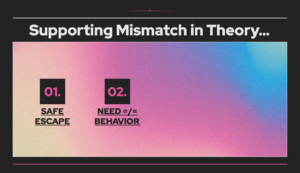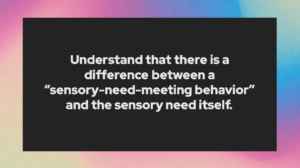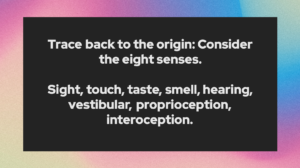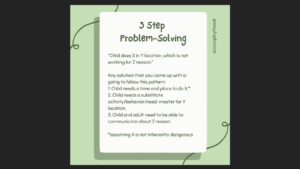In my last post, I shared the first tool for dealing with sensory mismatch. Today I’ll share another tool.
Just like in the last post, some of the things I say in this post may be tricky to understand if you haven’t read any of my past posts about sensory processing or some of the terms involved. That’s okay and it doesn’t mean anything about you as a person for not knowing this. This is soooo much to learn newly all at once! If it helps, think of this post as being a “201” and there have been some previous ones that were the “101”. You may not understand this without going through those first — for example, if you don’t know what ‘vestibular‘ means, ‘proprioceptive‘ means, ‘interoception‘ means, or if you just need a primer on sensory processing in general.
The next key tool that can help with sensory mismatch is knowing and understanding the difference between a “sensory-need-meeting behavior”, and the sensory need itself. I know that might just sound like jargon. Let me explain what I mean.

I had a student I worked with, “Aidan” who had a lot of challenges around running from his classroom. The teacher might look at me and say, “Well, what am I supposed to do? I can’t exactly meet the need to run while you’re in a classroom.”
The need to run is the sensory-need-meeting behavior. It’s what Aidan’s body is doing by default to meet the sensory need.

But the sensory need isn’t “to run”. We know this because “run” is not one of the eight senses (sight, hearing, touch, taste, smell, proprioception, vestibular processing, interoception).

Run is under the category of proprioception, and vestibular input. It causes movement in the inner ear to run and move your body. It causes exertion in the muscles and heavy feedback through the legs and hips and joints to run.
The sensory need for Aidan could be movement in the inner ear – vestibular input. The sensory need for Aidan could be exertion in the muscles – proprioception. We could try things that fit those two categories to see if those meet Aidan’s needs. We could try having him get movement in his inner ear by sitting in an office chair that he can push back from his table and spin around in when he starts to get overwhelmed. We could try having him get exertion in his muscles by grabbing heavy cardboard and ripping or cutting it when he gets overwhelmed and angry.
With Aidan specifically, I had a history of knowing that he used to flip over tables and chairs when he was angry. This is another form of exertion, so that gives me a clue that his thing might be exertion, not movement. That gives me other alternates to suggest. The alternates are all still rooted in the same sensory need, and the alternates are all different sensory-need-meeting behaviors.

There are 3 components of substituting people’s sensory needs:
1. The need being expressed and the exact way they’re currently expressing it could be taken as: Aidan sometimes needs to run. Maybe that happens at recess or PE.
2. The current environment where the need is being expressed could be taken as: In class, Aidan needs a substitute way to get proprioceptive feedback. Maybe that’s ripping cardboard when he’s frustrated or squeezing putty. Maybe it’s doing jumping jacks in the back of the room.
3. The thing that’s NOT working right now needs a way to communicate about what’s not working right now: The teacher needs a way to gently and non-threateningly remind Aidan to try out his proprioceptive tool in class before he gets overwhelmed.
This breakdown could also apply in lots of areas of life, this 3-part breakdown.
“Child does X in Y location, which is not working for Z reason.”
Any solution that you come up with is going to follow this pattern:
1. Child needs a time and place to do X.*
2. Child needs a substitute activity/behavior/need-meeter for Y location.
3. Child and adult need to be able to communicate about Z reason.
*assuming, of course, that X is not harmful in and of itself, but only due to location/other factors. If X is inherently harmful then obviously we don’t find a time and place for them to do it, but we just accept that step 2, finding a substitute, may be more complex and also more important, and step 3, being able to communicate and remind them, is also probably more complex and more important.
Here’s another example. I might, as a parent, struggle with yelling when things get overwhelming in my house with my kids. How am I supposed to manage that? It’s not like I can just yell at my kids and then say “well I needed to, it was a sensory need.”
So yelling is my sensory-need-meeting behavior, but it’s not the sensory need itself. The sensory need itself might be the need for quiet; I’m yelling because it’s at least a noise I’m in control of, as opposed to whatever other noise is happening that I’m not in control of. The sensory need might be the need for vibration, a tactile and proprioceptive need, because the vibration of my voice ringing through my abdomen and neck and shoulders and jaw is a heavy and regulating burst of input. I could try wearing earplugs when things start to get noisy. I could try putting on a vibrating neck pillow so that I can get white noise and vibration feedback to help me stay regulated.
1. The need being expressed and the exact way they’re currently expressing it could be taken as: I sometimes need to yell. Maybe I can do that in my car when I listen to music and feel like rocking out.
2. The current environment where the need is being expressed could be taken as: When it’s getting loud in my house, I need a way to manage my sensory overwhelm. Maybe I can wear earplugs or a buzzy neck pillow.
3. The thing that’s NOT working right now needs a way to communicate about what’s not working right now: I need a visual cue or a check-in with myself so I don’t get overwhelmed and yell. I could leave my neck pillow out on the counter in the kitchen where I’m usually standing when it starts to get loud in the evenings.
This part of things might feel really complicated at first and it can help to physically write some of it out or reference the eight senses when you’re trying to figure out what’s going on for the child, what underlying need might be beneath their behavior. I write about this kind of thing on my page all the time, and if you have an OT or are seeking OT, an occupational therapist can definitely help with this process too, because it requires you to kind of have an understanding of the senses and sensory processing styles and what all that means.
***



